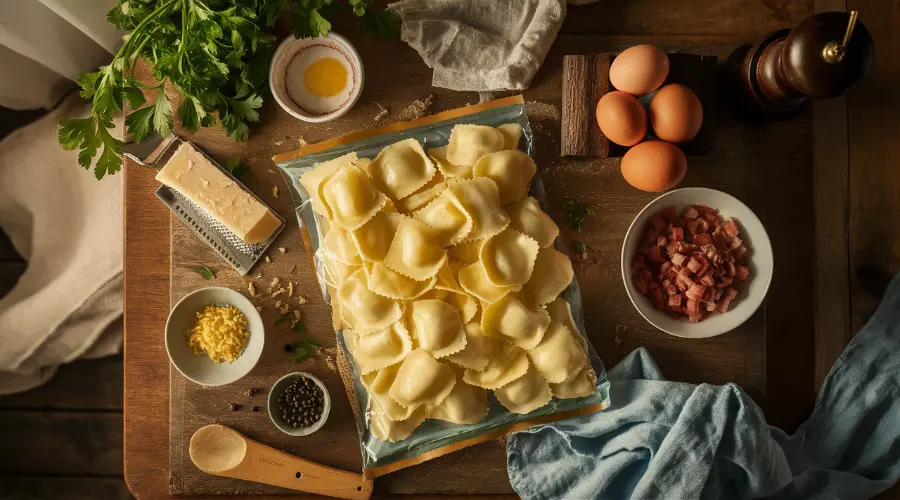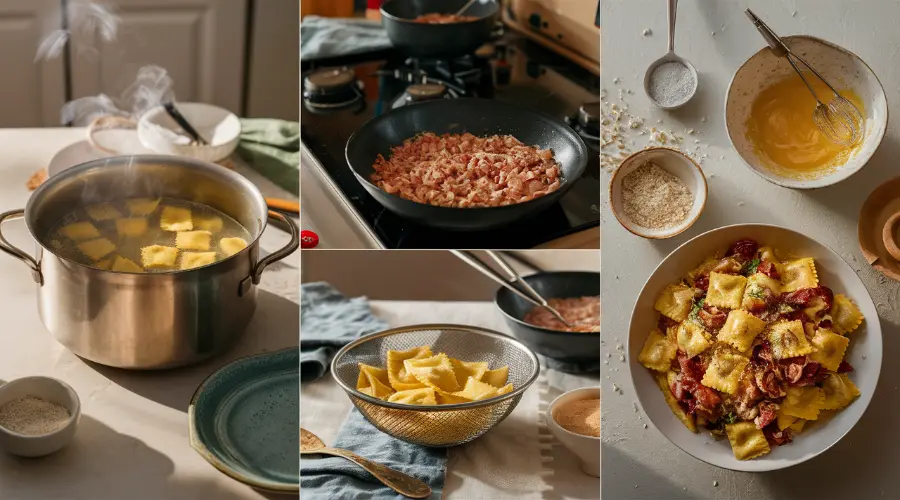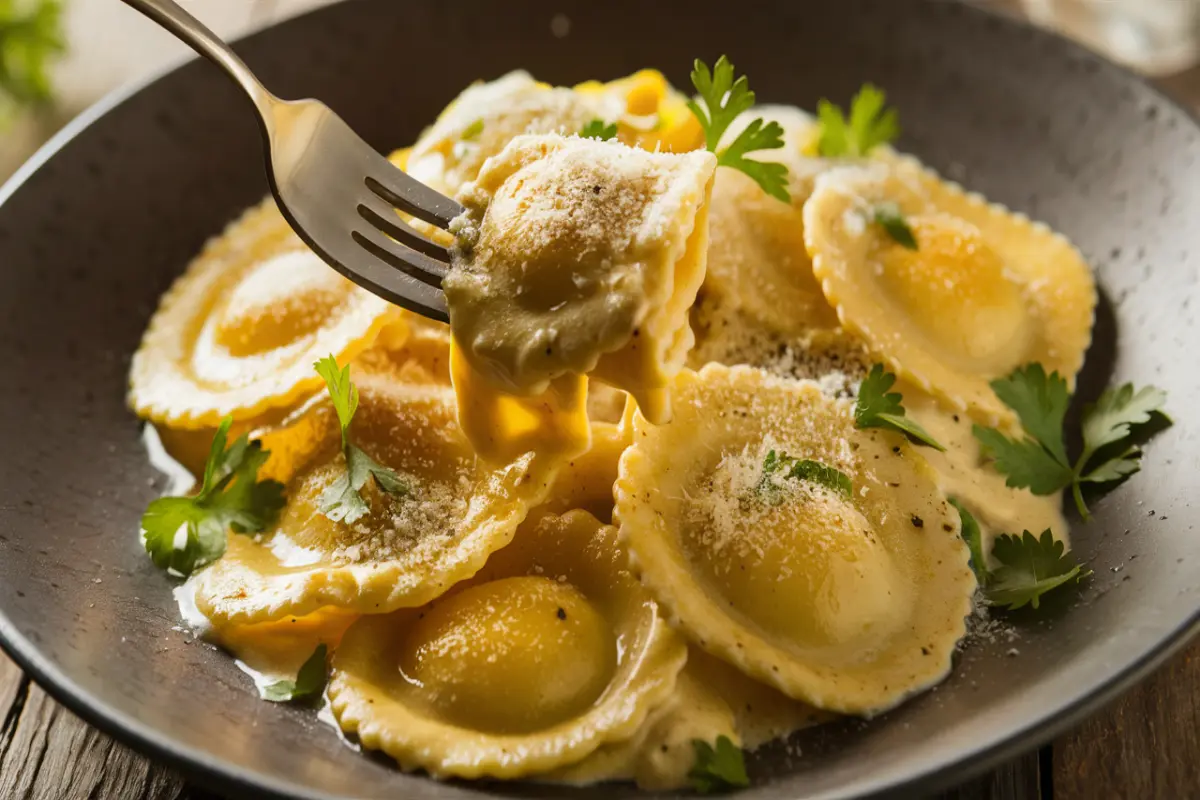Ravioli carbonara is a delightful fusion of two classic Italian dishes: ravioli, known for its soft pasta pockets filled with rich fillings, and carbonara, a creamy, savory sauce made from eggs, cheese, pancetta, and black pepper. This combination brings together the best of both worlds, resulting in a comforting and indulgent meal that’s perfect for any occasion.
In this article, we’ll dive into the world of ravioli carbonara, exploring its origins, ingredients, and step-by-step preparation. We’ll guide you through making this delicious dish at home, offering tips and variations to suit your taste. Whether you’re an experienced cook or a beginner in the kitchen, you’ll find this guide helpful for mastering the art of ravioli carbonara. Let’s embark on this culinary journey together!
What is Ravioli Carbonara?
Ravioli carbonara is a creative twist on the traditional carbonara pasta dish. Carbonara sauce, originating from Rome, is traditionally made with eggs, hard cheese (such as Pecorino Romano or Parmesan), pancetta or guanciale, and freshly cracked black pepper. This sauce is known for its creamy texture without the use of cream, relying instead on the emulsion of eggs and cheese.
Combining this rich, silky sauce with ravioli adds a new dimension to the dish. Ravioli, small pasta pockets filled with ingredients like cheese, spinach, or meat, pairs perfectly with the creamy carbonara sauce. The result is a dish that is both hearty and elegant, combining the comforting nature of stuffed pasta with the luxurious taste of carbonara.
The appeal of ravioli carbonara lies in its simplicity and flavor. It’s a dish that brings together the familiar comfort of pasta with the decadent sauce of carbonara, making it a popular choice for those looking to enjoy a unique Italian meal. This fusion dish offers endless possibilities for customization, allowing you to choose your favorite ravioli fillings and adjust the sauce to your liking.
Ingredients Needed for Ravioli Carbonara

To make the perfect ravioli carbonara, you’ll need a few key ingredients. Here’s a breakdown of what you’ll need and some variations to consider:
Ravioli Selection
The type of ravioli you choose can greatly affect the flavor profile of your dish. Here are some options to consider:
- Cheese Ravioli: A classic choice that pairs well with carbonara sauce, offering a creamy, cheesy filling that complements the sauce’s richness.
- Spinach and Ricotta Ravioli: Adds a touch of freshness and lightness, balancing the richness of the carbonara sauce.
- Mushroom Ravioli: Offers a deeper, earthier flavor, perfect for those who love a more robust taste in their pasta dishes.
- Meat-Filled Ravioli: For a heartier meal, use ravioli filled with ground meat like beef or sausage, which adds extra protein and flavor to the dish.
Carbonara Sauce Ingredients
The carbonara sauce is the star of this dish. Here are the essential ingredients for an authentic carbonara sauce:
- Eggs: The base of the sauce, providing a creamy texture without the need for cream. Use fresh, high-quality eggs for the best flavor.
- Pancetta or Guanciale: Traditional carbonara uses guanciale, a type of Italian cured pork cheek. Pancetta, an Italian cured bacon, is a great alternative and more readily available.
- Parmesan Cheese (or Pecorino Romano): Grated cheese is key to the sauce’s flavor and texture. Pecorino Romano provides a sharper, saltier taste, while Parmesan offers a milder, nuttier flavor.
- Black Pepper: Freshly cracked black pepper adds a spicy kick that complements the richness of the sauce. Use freshly ground pepper for the best results.
Optional Ingredients and Variations
For those looking to add a twist to the classic recipe, consider incorporating these optional ingredients:
- Vegetables: Peas, spinach, or mushrooms can add a fresh element to the dish.
- Herbs: Fresh basil, parsley, or chives can be sprinkled on top for added color and flavor.
- Alternative Proteins: For a different take, try substituting pancetta with smoked salmon or turkey bacon.
By selecting the right ingredients, you can tailor your ravioli carbonara to suit your preferences and create a dish that is uniquely yours.
How to Make Ravioli Carbonara: Step-by-Step Recipe

Making ravioli carbonara at home is easier than you might think. Follow these steps to create a delicious and creamy dish:
Preparing the Ingredients
- Gather and Prep Ingredients: Begin by preparing all your ingredients. Grate the cheese, crack the eggs into a bowl, and beat them lightly. Dice the pancetta or guanciale into small cubes.
- Prepare the Ravioli: If using store-bought ravioli, keep them in the refrigerator until ready to cook. If making homemade ravioli, ensure they are assembled and ready to boil.
Cooking the Ravioli
- Boil Water: Fill a large pot with water and add a generous amount of salt. Bring the water to a rolling boil over high heat.
- Cook the Ravioli: Add the ravioli to the boiling water. Stir gently to prevent sticking. Cook according to the package instructions or until the ravioli float to the top, indicating they are done. Typically, this takes 3-4 minutes for fresh ravioli and 8-10 minutes for frozen.
- Drain and Reserve Water: Reserve 1/2 cup of the pasta cooking water, then drain the ravioli and set aside.
Making the Carbonara Sauce
- Cook the Pancetta or Guanciale: In a large skillet over medium heat, cook the diced pancetta or guanciale until it is crispy and the fat is rendered. This should take about 5-7 minutes. Remove the skillet from the heat and set aside.
- Prepare the Sauce Base: While the pancetta is cooking, mix the beaten eggs with the grated cheese in a bowl. Add a generous amount of freshly cracked black pepper. The mixture should have a thick, creamy consistency.
- Combine with Pasta Water: Slowly add a few tablespoons of the reserved pasta water to the egg mixture, whisking continuously to temper the eggs. This will prevent the eggs from scrambling when added to the hot pan.
Combining Ravioli and Carbonara Sauce
- Mix Ravioli with Sauce: Add the cooked ravioli to the skillet with the pancetta. Over low heat, pour the egg and cheese mixture over the ravioli, tossing gently to coat.
- Adjust Sauce Consistency: If the sauce is too thick, add a bit more of the reserved pasta water, one tablespoon at a time, until the sauce reaches the desired consistency. The sauce should be creamy and cling to the ravioli without being too runny.
- Serve Immediately: Plate the ravioli carbonara immediately, garnishing with extra cheese and a sprinkle of black pepper.
Tips for Perfect Ravioli Carbonara
Creating the perfect ravioli carbonara at home requires attention to detail. Here are some essential tips to help you achieve a delicious dish every time:
Achieving the Perfect Sauce Consistency
To achieve a smooth and creamy carbonara sauce, it’s crucial to pay attention to the sauce’s texture. First, when combining the egg and cheese mixture with the hot pasta, move quickly and stir constantly. This ensures that the eggs do not scramble, which would lead to a grainy texture rather than a smooth, silky sauce. Additionally, adding pasta water gradually helps in emulsifying the sauce, making it creamy without becoming too thick or clumpy. Always use low heat during this process to avoid overheating the eggs.
Choosing the Right Cheese and Pancetta
Selecting the best ingredients is key to a flavorful dish. Parmesan cheese is often the go-to for carbonara, but Pecorino Romano can add a sharper, saltier taste that enhances the overall flavor. Similarly, using guanciale, an Italian cured pork cheek, gives a more authentic taste compared to pancetta, which is a bit milder. However, pancetta is more widely available and still provides a rich, savory flavor. For an extra flavor boost, use a combination of both cheeses, and always choose high-quality pancetta or guanciale.
Avoiding Common Mistakes
One common mistake when making carbonara is letting the sauce become too thick or curdled. To avoid this, never pour the egg mixture directly onto the hot pan or skillet. Instead, allow the pan to cool slightly before adding the mixture, or better yet, take it off the heat entirely. Another common error is overcooking the ravioli, which can cause them to burst or become mushy. Always follow the cooking instructions carefully and check for doneness frequently to ensure the pasta is cooked just right.
Adding a Twist
If you’re looking to add a personal twist to your ravioli carbonara, consider incorporating additional ingredients. For example, adding peas or spinach provides a pop of color and a bit of freshness, balancing the richness of the sauce. Mushrooms can add an earthy depth, while a touch of lemon zest can brighten up the flavor profile. Alternatively, for those who enjoy a bit of spice, a pinch of red pepper flakes can give the dish a subtle kick. The key is to experiment with different ingredients and find a combination that suits your taste.
Serving Suggestions for Ravioli Carbonara

Presentation and pairing can elevate your ravioli carbonara from a simple meal to a gourmet experience. Here are some serving suggestions to make your dish truly shine:
Plating and Presentation
When it comes to plating, presentation matters. Start by placing a generous portion of ravioli carbonara in the center of each plate. To add visual appeal, sprinkle freshly grated Parmesan cheese on top, followed by a few twists of freshly cracked black pepper. For a pop of color, garnish with fresh parsley or basil leaves. A drizzle of extra virgin olive oil around the plate adds a touch of elegance. Remember, a beautiful presentation can make the dish look as delicious as it tastes.
Side Dishes and Accompaniments
Pairing ravioli carbonara with the right side dishes can enhance the overall meal experience. A simple green salad with a light vinaigrette complements the richness of the carbonara sauce. Garlic bread or a crusty baguette is perfect for soaking up any leftover sauce. Roasted vegetables, such as asparagus, broccoli, or cherry tomatoes, add a healthy element and provide a nice contrast in flavor and texture. Additionally, serving the dish with a light soup, like a minestrone or a clear broth, can help balance the richness of the pasta.
Health Considerations and Nutritional Information
While ravioli carbonara is undeniably delicious, it’s also a rich dish, so it’s important to be mindful of its nutritional content. Here’s a breakdown of what to consider:
Calorie Content and Nutritional Value
Ravioli carbonara is high in calories due to its rich ingredients like cheese, eggs, and pancetta. A standard serving can range from 400 to 600 calories, depending on portion size and ingredients used. It’s also high in fat, particularly saturated fat, due to the cheese and cured meat. However, it does provide a good source of protein from both the eggs and the pasta filling, and if you add vegetables like spinach or peas, you can increase the fiber content as well.
Making a Lighter Version
To make a lighter version of ravioli carbonara, consider using turkey bacon or lean prosciutto instead of pancetta, which reduces the fat content while still providing a savory flavor. Opting for low-fat Parmesan or Pecorino can also cut down on calories. Additionally, using a smaller amount of cheese and adding more vegetables like peas or mushrooms can bulk up the dish without adding too many extra calories.
Dietary Modifications
For those with dietary restrictions, there are several ways to modify ravioli carbonara. For a gluten-free option, use gluten-free ravioli, which is available at most supermarkets. To make the dish dairy-free, substitute dairy-free cheese and a plant-based alternative to pancetta, like tempeh bacon or a smoky mushroom mixture. These adjustments allow you to enjoy this comforting dish while adhering to your dietary needs.
Frequently Asked Questions About Ravioli Carbonara
Here are answers to some common questions about making and enjoying ravioli carbonara:
Can You Make Ravioli Carbonara Without Eggs?
Yes, you can make a variation of carbonara without eggs, although it won’t be traditional. To achieve a similar creamy texture, use a dairy-based alternative like heavy cream or a non-dairy creamer thickened with a bit of cornstarch. Mix this with cheese, garlic, and black pepper to create a sauce that resembles carbonara in flavor and texture.
How Do You Store Leftover Ravioli Carbonara?
To store leftover ravioli carbonara, transfer it to an airtight container and refrigerate for up to 3 days. When reheating, it’s best to use a skillet over low heat. Add a splash of water or milk to help loosen the sauce and stir gently to avoid breaking the ravioli. Avoid using a microwave, as it can cause the pasta to become rubbery and the sauce to separate.
What Are Some Vegetarian Alternatives for Carbonara Sauce?
For a vegetarian carbonara sauce, replace the pancetta with sautéed mushrooms, which provide a savory, umami flavor. You can also use roasted vegetables like zucchini or bell peppers. Alternatively, try smoked tofu or a plant-based bacon substitute for a similar texture and flavor. These options allow vegetarians to enjoy a version of this classic dish that still feels rich and satisfying.
Can You Freeze Ravioli Carbonara?
Freezing ravioli carbonara is not recommended, as the sauce may not hold up well to freezing and reheating, potentially resulting in a grainy texture. However, if you do decide to freeze it, place the pasta in an airtight container and freeze for up to one month. To reheat, thaw in the refrigerator overnight and then gently warm on the stovetop, adding a little milk or cream to help restore the sauce’s consistency.
Conclusion
Ravioli carbonara is a delicious fusion of two beloved Italian dishes, combining the comforting flavors of filled pasta with the rich, creamy sauce of carbonara. This dish is versatile, allowing for endless customization based on your preferences. Whether you prefer a classic version with cheese ravioli or want to experiment with different fillings and additions, ravioli carbonara is sure to impress.
By following the tips and recipes provided in this article, you can create a restaurant-quality meal in your own kitchen. From selecting the right ingredients to mastering the perfect sauce consistency, each step is crucial for achieving the best results. Don’t be afraid to get creative and make the dish your own.
So, gather your ingredients, fire up your stove, and enjoy the delicious, comforting flavors of ravioli carbonara. With a little practice and experimentation, you’ll soon have a new favorite recipe that’s perfect for any occasion. Buon appetito!
